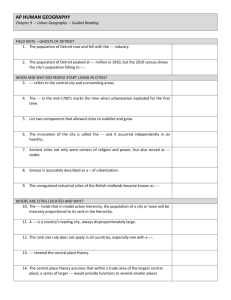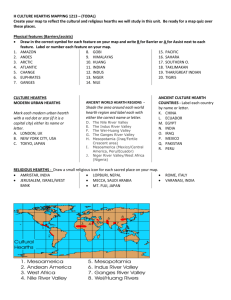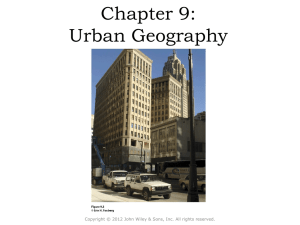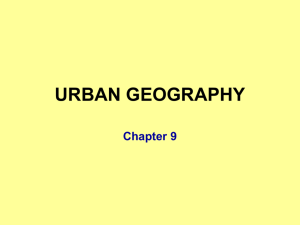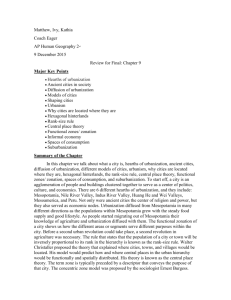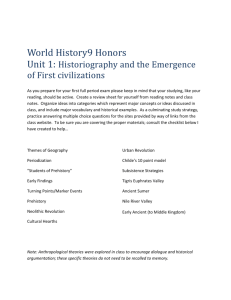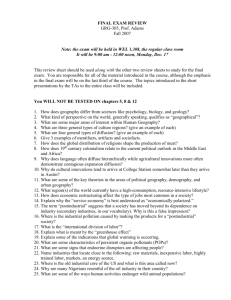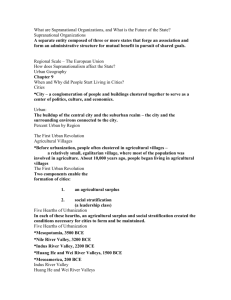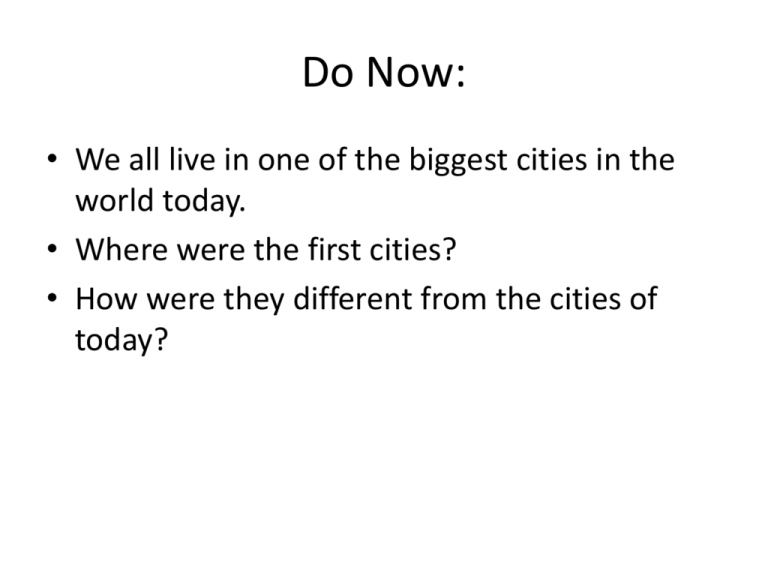
Do Now:
• We all live in one of the biggest cities in the
world today.
• Where were the first cities?
• How were they different from the cities of
today?
Aim: When and why did
people start living in cities?
Field Note:
Ghosts of Detroit?
“The semicircular shaped Grand
Circus Park in Detroit, Michigan is
divided by several streets, making
it look like the hub and spokes of a
bicycle wheel from above. The
grouping of buildings along Grand
Circus Park (Fig 9.1) reflects the
rise, fall, and revitalization of the
central business district (CBD) in
Detroit. The central business
district is a concentration of
business and commerce in the
city’s downtown…Abandoned highrise buildings called the ghosts
of Detroit are joined by empty
single-family homes to account for
10,000 abandoned buildings in the
city.”
When and Why Did People Start
Living in Cities?
• Urban: the built-up space of the central city and
suburbs
• Includes the city and surrounding environs
connected to the city
• Is distinctively nonrural and nonagricultural
• A city is an agglomeration of people and
buildings clustered together to serve as a
center of politics, culture, and economics.
Concept caching:
Kansas City, MO
© Barbara Weightman
What benefits do cities afford to its
people?
Cities then and Now
• In the late 20th century China announced a major
economic development project in Guangdong.
• They established a special economic zone (SEZ) and
business and industry boomed.
• The city of Shenzhen was drastically changed.
Need to Know Dates
• What we do today with cities took thousands
of years to develop originally.
• Human communities have existed for over
100,000 years.
• 8,000 years ago first cities established.
• But only 200 years ago did cities resemble
what they are today.
The Hearths of Urbanization
• Switch from hunter and gather to agriculture
happened before urbanization.
• Early Ag between 10,000-12,000 years ago.
• First cities came after agriculture.
• First was Catal Huyuk as a village not a city.
• They were small in size and population.
The Hearths of Urbanization
• Two components enabled cities to stabilize and
grow:
• Agricultural surplus and Social stratification
• Two competing theories on what led to them
• Advances in irrigation led to a surplus in agriculture
and a leadership class formed to control the surplus
and technology to produce it.
• A king or priest demanded more labor to generate
an agricultural surplus to help them retain power.
The Hearths of Urbanization
• The leadership class, or urban elite,
consisted of a group of decision makers
and organizers who controlled the
resources.
• They controlled the food supply, production,
storage, and distribution.
• They did not work the fields.
• Devoted time to pursue religion and philosophy.
• Led to writing and record keeping.
• Writing made possible the codification of laws and
the preservation of traditions.
The Hearths of Urbanization
• The innovation of the city is called the first
urban revolution, and it occurred
independently in six separate hearths, a
case of independent invention.
• The six urban hearths are tied closely to
agriculture.
Need to Know Dates
The Six Hearths of Urbanization
1.
2.
3.
4.
5.
6.
Mesopotamia, 3500 B.C.E.
Nile River Valley, 3200 B.C.E.
Indus River Valley, 2200 B.C.E.
Huang He Valley, 1500 B.C.E.
Mesoamerica, 1100 B.C.E.
Peru, 900 B.C.E.
The Fertile Cresecent
• Cities of Ur and Babylon. Located between the
Tigris and Euphrates rivers. Showed signs of social
classes based on sized of houses.
• A mud wall protected the city.
• Temples and shrines at the center.
• Temples dominated the landscapePriests resided in
palaces.
• Ordinary citizens in mud walled houses very close to
each other.
© 2012 John Wiley & Sons, Inc. All rights reserved.
The Nile River Valley
• Interrelationship between urbanization and
irrigation.
• The might of the rulers is seen in the feats of
their architecture.
• They built the pyramids, tombs, and the
sphinx.
• Theories hold that slaves built the pyramids
but today archeology claims ordinary citizens
built them as part of their tax payment
Indus River Valley
• First cities were Harappa and Mohenjo-Daro.
• Intricate planning with a leadership class but all the
houses was equal in size.
• No palaces or monuments.
• All dwellings had access to the same infrastructure
• Wastewater drains and stone lined wells.
• Cities had thick walls
• Discovered coins from far way indicating significant
trade.
© 2012 John Wiley & Sons, Inc. All rights reserved.
Huang He and Wei Valleys
• the yellow and Yangtze rivers. Dating back to 1500 BCE.
• Purposefully planned their cities with a vertical
structure are the center and built the city around it.
• Inner wall had the temples and palaces.
• Leadership class built enormous and elaborate
structures.
• 200 BCE Emperor Qin Xi Huang directed the building of
the Great Wall.
• He built an elaborate mausoleum for himself.
• 7,000 terracotta warriors stand guard over his burial
place.
© 2012 John Wiley & Sons, Inc. All rights reserved.
Mesoamerica
• Cities were religious centers.
• Olmec built San Lorenzo and the gulf coast of
Mexico.
• They carved stone monuments.
• Olmec civilization died out but the Maya built
cities in the same region also centered around
religious temples.
• Tikal, Chichen –Itza, Uxaml, and Copan.
© 2012 John Wiley & Sons, Inc. All rights reserved.
Peru
• they Chavin built cities.
• The largest was 10,530 feet in the Andean
highlands.
•
Summary:
• In todays landscape can we see evidence of
ancient civilizations still in practice today?
Explain.

